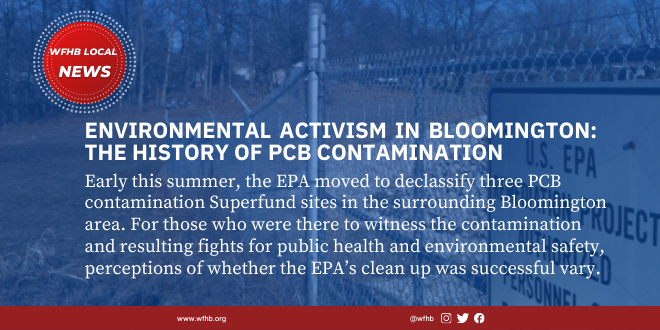Podcast: Play in new window | Download (Duration: 10:30 — 14.5MB)
Subscribe: RSS
Early this summer, the U.S. Environmental Protection Agency moved to declassify three PCB contamination Superfund sites in the surrounding Bloomington area.
The decommission of these clean up sites from the National Priority List draws a decades long local environmental movement to a close. For those who were there to witness the contamination and resulting fights for public health and environmental safety, perceptions of whether the EPA’s clean up was successful vary.
Yet there seems to be a consensus – that this story of community activists rallying in the wake of environmental catastrophe has earned Bloomington a spot in the history books.
Journalist and Professor Steven Higgs has been following the story of PCB contamination in Southern Indiana every step of the way, starting all the way back with the initial contamination.
“In terms of contamination from one source, Westinghouse, this is the biggest in the entire United States,” said Higgs.
In the wake of the mass contamination of such a toxic substance, public officials at all levels of government began the urgent search for a clean up solution. The EPA came out with a proposal to address the contamination along with another common local environmental issue.
“The mayor’s office along with the state of Indiana, the EPA, their solution was to build an incinerator,” he said, “that was going to burn the PCBs at 2000 degrees, and they were going to fuel it with trash.”
The idea to use solid waste as fuel to burn PCBs in an incinerator may sound innovative in theory, but in practice issues quickly begin to arise. One problem being that trash would be an extremely inefficient resource. Common solid wastes are made up of materials that would likely not be able to heat the PCBs to intense heat necessary for their destruction.
Another issue presented by the incinerator solution had community members band together in order to halt the clean up process:
“Because of the potential health risks that were going to come from the PCB incinerator,” said Higgs, “people in this community rose up and fought it tooth and nail.”
Community member Linda Greene, a member of People Against the Incinerator, was one such activist. Greene explains the difficult road those opposed to the incinerator faced.
“It was a very difficult and exhausting process, because we were up against everybody,” she said. “We just made a fuss constantly.”
Ultimately, their civic engagement and environmental activism was successful, and the incinerator plan was discarded. Professor Higgs explains that though many public officials were sure the incinerator was a safe solution, public outrage at the prospect of further toxic pollution won out.
“They never backed down from the fact that it was a good idea, but politically, it just became untenable, because when you burn 650,000 cubic yards of contaminated materials, you get 650,000 cubic yards of ash. And that had to go someplace,” said Higgs.
After the hard fought battle against the incinerator, the EPA still had to come up with a solution to the PCB problem. A local consent decree laid out the plan to capture and remove PBC from the Southern Indiana environment and take the toxic materials elsewhere for treatment.
Now, after decades of the capture and removal process, the EPA’s move to declassify the superfund sites signals a successful clean up.
However, some community members are still skeptical. With health concerns at the core of toxic contamination and years of fighting for a safe clean up, Linda Greene points out that people may be wary of believing the EPA’s claims.
“I think there’s a tremendous amount of corruption at all levels. I think the official story is making it look like it’s all taken care of. I think there’s still a problem here,” said Greene.
However, Thomas Alcamo, the EPA’s Remedial Project Manager for the Bloomington sites,
reassures that the clean up process has been rigorous and there will be routine check ups from the federal government and their contractors, as is standard practice in the declassification process.
Higgs concurs with this opinion that the EPA has done all that can be done.
“It’s probably been as effective as it could be, but it’s just so omnipresent,” he said. “Every human being, you have PCBs in your body. There’s not a person on the planet, I don’t believe, who doesn’t have PCBs and honestly a couple hundred other toxic chemicals.”
Specific contamination sites are likely no longer a hazard here, thanks to the EPA Superfund cleanup process and the relentless work of community members.
However, the now widespread reach of PCBs alludes to a greater problem on the horizon – environmental threats, contamination-based or otherwise – are likely to escalate as climate change looms and pollution continues to rampage.
The story of PCBs in the Bloomington area creates a movement to emulate and one that highlights the importance of community action and protection at the local level. Let’s not forget this story of civil engagement in the face of environmental disaster.
 WFHB Bloomington Community Radio
WFHB Bloomington Community Radio


